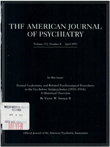An empirical study of defense mechanisms in dysthymia
Abstract
OBJECTIVE: The psychodynamic approach to understanding dysthymia has rarely been empirically tested. In this pilot study the Defense Mechanism Rating Scales were used to examine psychodynamic data from patients with dysthymia and patients with panic disorder in order to test the hypotheses that 1) dysthymic patients would be similar to panic patients in endorsing primarily lower-maturity defense mechanisms, 2) dysthymic patients would use a distinct pattern of defense mechanisms, different from that of panic patients, and 3) dysthymic patients would endorse more frequently than panic patients four individual defenses that tend to handle anger and low self-esteem poorly: devaluation, passive aggression, projection, and hypochondriasis. METHOD: Twenty-two subjects meeting the DSM-III-R criteria for primary early-onset dysthymia and 22 subjects meeting the DSM-III-R criteria for primary panic disorder were interviewed on videotape and rated on the Defense Mechanism Rating Scales. RESULTS: The dysthymic subjects scored significantly higher on narcissistic, disavowal, and action defense levels and on the four individual defenses of devaluation, projection, passive aggression, and hypochondriasis, as predicted, as well as on two additional defenses, acting out and projective identification. Both groups tended to use lower-maturity defense mechanisms. CONCLUSIONS: The defense mechanism profile identified for dysthymia differs from that for panic disorder and supports particular psychodynamic hypotheses about chronic depression. It could be useful in devising treatment strategies and as a measure of treatment efficacy.
Access content
To read the fulltext, please use one of the options below to sign in or purchase access.- Personal login
- Institutional Login
- Sign in via OpenAthens
- Register for access
-
Please login/register if you wish to pair your device and check access availability.
Not a subscriber?
PsychiatryOnline subscription options offer access to the DSM-5 library, books, journals, CME, and patient resources. This all-in-one virtual library provides psychiatrists and mental health professionals with key resources for diagnosis, treatment, research, and professional development.
Need more help? PsychiatryOnline Customer Service may be reached by emailing [email protected] or by calling 800-368-5777 (in the U.S.) or 703-907-7322 (outside the U.S.).



